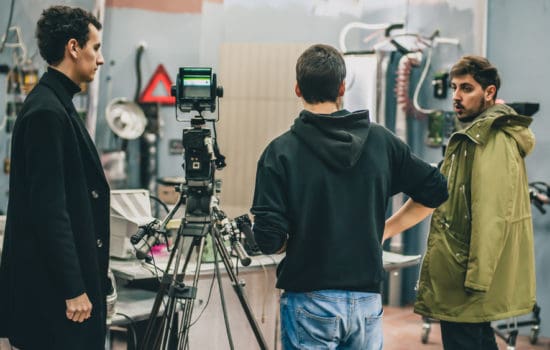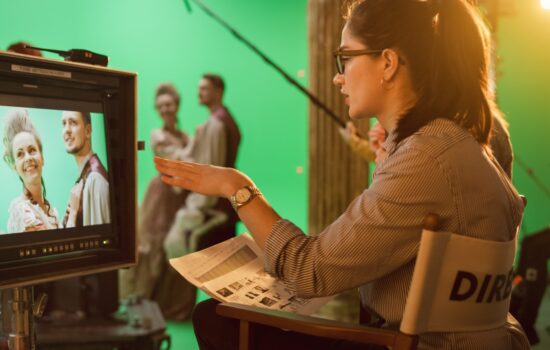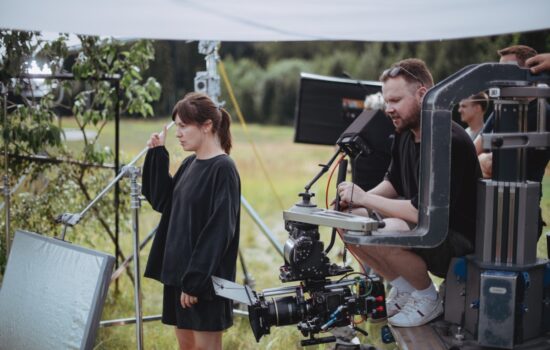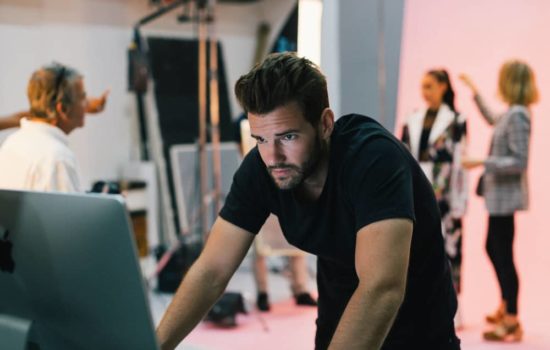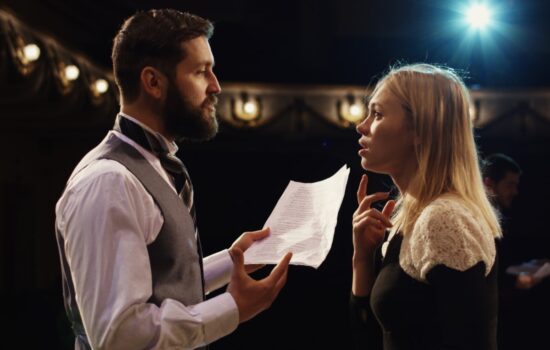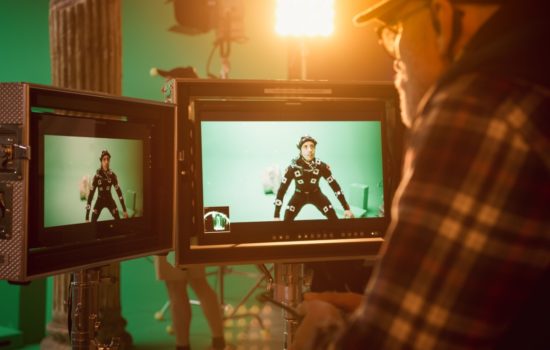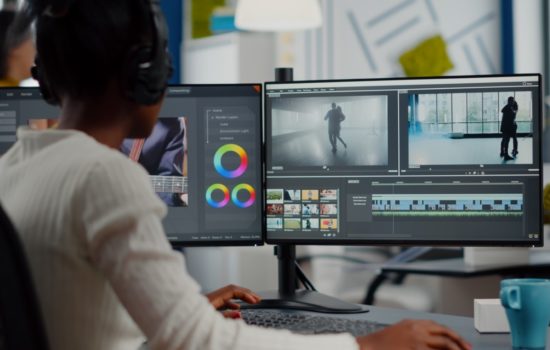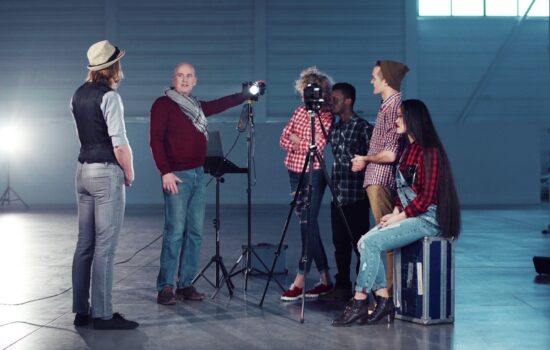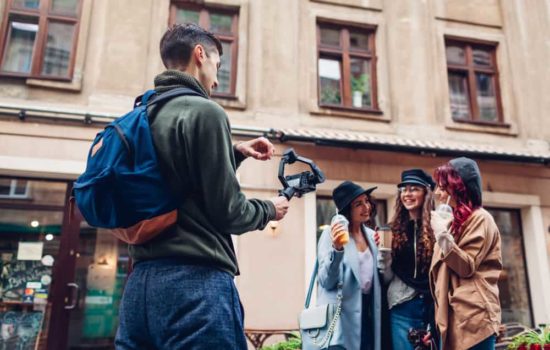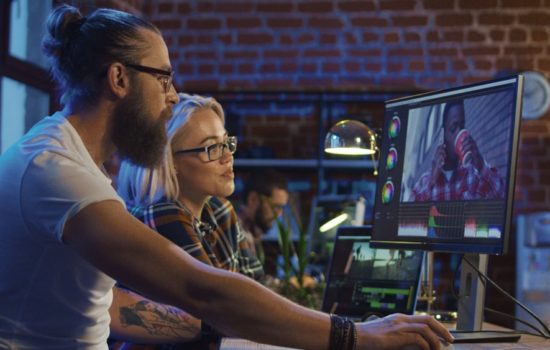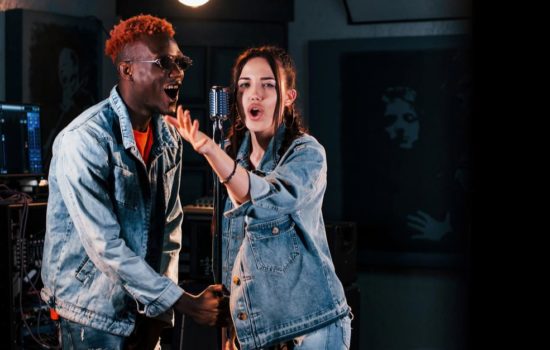Dolly Grip
Career Overview
Dolly Grips prepare a location or set for camera motion and support the camera any time it is moving. They lay protective flooring according to the scene blocking, hold the camera when it is rigged to any moving vehicle or equipment, and push and pull the dolly along track or across the floor.
Alternate Titles
A Dolly Grip, B Dolly Grip
Salary Range
$100K-$300K
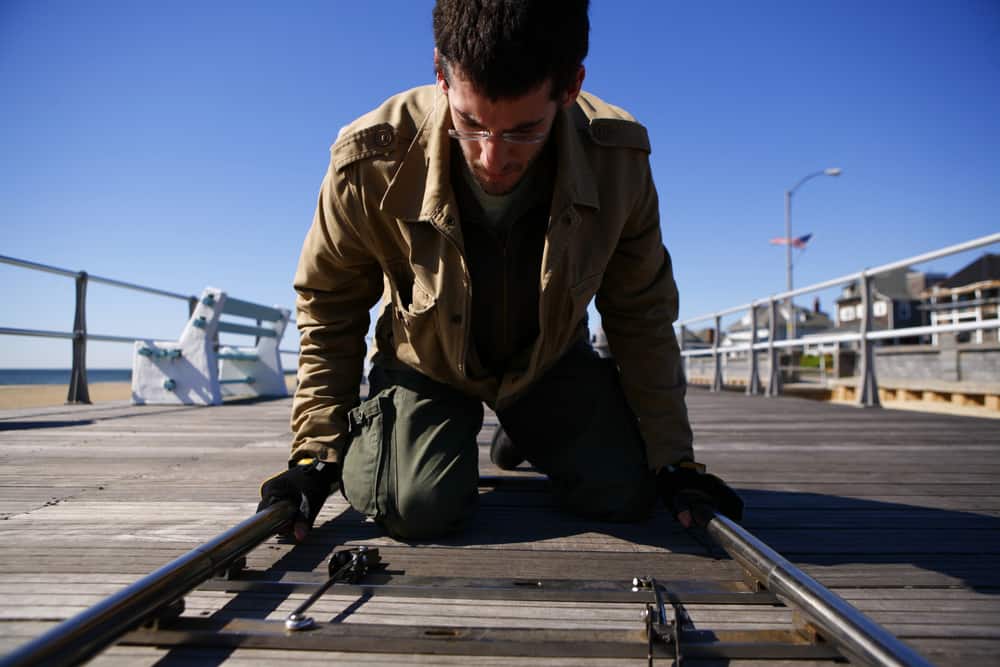
How To Become a Dolly Grip
People also ask
Career Description
Kenny Davis is a veteran Dolly Grip, with extensive high-profile feature credits including Soderbergh’s Logan Lucky, Fuqua’s The Magnificent Seven and Nolan’s Memento. He sheds light on the nebulous nuances of being a Dolly Grip:
“As a Dolly Grip, you’re more part of the Camera Department because our job is camera support, movement, animation of the camera in many shapes and forms. I support the camera itself any time it’s in motion. It doesn’t necessarily mean the camera is actually on a dolly or on track.”
Davis breaks apart the specific roles around the camera any time there is movement: “An Operator holds the camera and there’s an AC (Assistant Camera) to pull focus. But even that is being done more and more remotely. They’re often not present at the camera; nowadays, physically on the camera are the Dolly Grip and the Operator. The AC will pull focus remotely.”
Davis goes into the technicalities of how much the industry is changing from a technological point of view, and how it affects his day-to-day:
“These days, particularly with the Soderbergh movies I’ve been doing, we use a Ronin head (a gyroscopically/electronically stabilized head) — it’s a carbon-fiber head that goes on a short arm, like a Steadicam arm, with spring-loaded shock absorbers to absorb vibration and bounce. This way, we can actually move on regular existing floor: sidewalk, marble, a floor in a house, anything like that.”
In these cases, it’s just the Dolly Grip on the camera while the Operator works remotely. Davis continues: “It’s me physically pushing a dolly with the camera suspended, floating, on the shock absorbed arm and head. I become an Operator and the Dolly Grip! Meanwhile, the Operator works remotely, spinning the dolly wheels, moving the camera left and right. In these scenarios, the workload equation shifts to a lot of Dolly Grip, and a little bit of Operator.”
Davis makes it clear that being a Dolly Grip is an extraordinarily physical job and you have to keep yourself in shape. Moreover, conditions on location can be brutal:
“I remember doing Magnificent Seven out in Louisiana; there was no shade and we were out in giant fields in well over 100° for a week straight. The heat will take it out of you. I’m about to go out to Savannah, Georgia with Bradford Davis to shoot a feature and it’ll be hellishly hot — I’ve been thinking about what I need to do to survive once I’m out there.
“The piece is about the Underground Railroad so we’ll be filming people running for their lives. I’m thinking of using an electric vehicle with a jib (an arm off the side with a self-leveling post) to keep up with the person running. I’ll hold the camera arm at the side of the car and we’ll follow the Actor. Practically, I’ll be controlling the tilt and pan out the side of a car in the searing heat!”
Davis goes on to explain that, day-to-day you have to keep fit and eat correctly: “The eating part is really hard for me because I love street food and Italian…but then you have to work out more, or only eat like that once in a while.
It’s about finding a routine that becomes habitual and works for you. Plus, when you’re shooting out on location and you’re away for periods of time, those are weeks when you can’t really work out during the long workdays.”
In terms of everyday relationships, Davis explains that you need a close, working relationship with the Operator because it’s collaborative, physical work. And Davis loves that aspect of the job: “I like the camaraderie. It’s like a bobsled team — the Operator operating, the AC pulling focus and me pushing the dolly.
The camera and equipment start to weigh a lot, especially with the long, one-shot moves that Soderbergh likes to do. It’s very intense at times, to have to hyper-focus like that.”
Davis digs further into the beautiful art of Dolly Gripping: “It’s literally a dance; you’re mimicking the Actor’s movements, backing up, following them. With Meryl Steep on the last piece, I’d lock into her speed, her cadence, when she stops, when she shuffles. You get a couple of rehearsals and, boom, you’re doing it.
“In fact, we almost always shoot the rehearsal as long as the Actors are comfortable with the blocking. I love the whole dance. And when we play it back, I’m always amazed that we pulled it all off and how well things photograph!”
With regards to the workflow on the day, the Cinematographer normally speaks to the Operator, but sometimes they’ll liaise with the Dolly Grip too. As Davis illustrates, “It’s a weird hierarchy thing — you have to know your place. If it’s people you’re comfortable with, and with whom you have a tight working relationship, there’s no weirdness — a filmmaker like Soderbergh knows that it takes an entire team so he briefs all of us about the shot we’re building.
“It’s collaborative and respectful. I’ve been doing this a long time so I’m very relaxed in these situations, especially when things heat up, literally. You have to stay mentally and physically cool when you’re doing twenty long takes in the heat.”
All in all, Davis celebrates the fact that Dolly Grips don’t really have a well-delineated boss: “We don’t fully belong to the Grip Department and we certainly don’t belong, officially, to the Camera Department. We’re dogs with no master.
The Key Grip usually hires me so I do ultimately defer to them, but there are certain times when the Cinematographer hires me and then the Key Grip doesn’t really care what I’m doing, apart from keeping my equipment on their truck.
“Coming up through the industry, you want to keep a good, solid relationship with the Key Grips — they are your HR at the end of the day, despite the unique flow of a Dolly Grip’s workday.”
What does a Dolly Grip do?
A Dolly Grip handles any camera mount needs, which typically consists of building and maintaining the mounting equipment. As their titles implies, they work with the camera dollies, which allow the camera to move along a track.
Salary
A Dolly Grip in demand can make a very comfortable $200,000-300,000 per year if they’re working on big movies all the time. Even the day-players getting 9-10 months of work can earn well over $100,000 per annum.
It’s all predicated on the amount you work, says Davis.
How much does a Dolly Grip make?
According to ZipRecruiter, a Dolly Grip makes an average annual salary of just under $39,000. Factors like their union status, volume of work in a year, and overall experience can affect this average.
Hey, what do you think about trying our new Film Career HelperFilm Career Helper really quick? It’s totally free and could help get your career moving fast! Give it a try. It’s totally free and you have nothing to lose.
Career Outlook
This is where Davis shifts tone and is eager to share some shrewd advice: “Be very, very careful with drugs and alcohol. They will take it out of you. You can lose yourself quickly when you’re young, and the industry does lend itself to a party atmosphere. You can ruin your career and family if it gets out of control.
“Not only that but after a hard night, you can’t get up in the morning and do ten to twelve hours of intense focus around the camera. You can do it for a while, but you will pay the price in the long-run.”
“Be aware. I’m sober now because I went hard at the beginning and it couldn’t go on. I’m not kidding around, it’s serious. Have a couple of beers, a glass of wine, sure, but be very conscious of your consumption on workdays.”
In terms of a work/life balance, Davis suggests taking the time for the people you love: “In my career, I always took every job. It became an obsession because I thought I’d never work again but, as you get older, you realize that’s ridiculous. I have a daughter and I travel with her in my downtime and I love it. Take time for your family when you can. It’s the best.”
Career Path
Davis remembers his particular journey, one of serendipity: “When I started doing this, I knew a physical job would fit me well. As for my first Dolly job, I remember the Key Grip on that particular shoot, Bloodhounds of Broadway with Madonna and Rutger Hauer, just didn’t want to push the dolly anymore, so he passed it off to me!”
Davis says he learned entirely on the job and never went to film school. In fact, he was a martial artist and wanted to be Bruce Lee, and insists his training really helped with the physical part of the job.
“My uncle was a guy who raised money for independent, low-budget movies in New York and I was bar-backing at a bar in Florida. When I got fired, he said, ‘You’re not doing anything with your life. I’m doing a movie up in Kentucky — drive my car to me in Louisville. If you wanna work on this movie, you can be a PA.’ The money was pretty fair, with per diems too, and I had nothing to go back to.
“We were shooting in a maximum-security prison and I watched the Grip Department carrying sandbags and dolly track into the prison and I was fascinated. I started helping them haul everything in from the parking lot so they loved me and snatched me up. And that’s how I got into grip.”
Many Dolly Grips do shift to Operating after a while: “The money is better, and if you have your own equipment like Steadicams, you can rent that out. I actually Key Grip smaller, independent shoots and let someone else do the pushing — I like to see the younger people coming up.”
Saying that, Davis is an experienced artist and fully dedicated to his craft. There are not many specialized, focused Dolly Grips and he clarifies why it pays off: “When the top Dolly Grips get gobbled up, you work all the time. It’s such a specialist position — people always need Dolly Grips. You’ll have such a specialism and your name will become synonymous with quality. Even if there are five better Dolly Grips, once they’re working, they come to you!
“You know, you have a 200mm lens, pushing in on a face as someone’s sliding down a wall and you’re tracking down and pushing in? It’s a serious skill! When you pull that off, that’s why you’re there — you’ve got that ability!”
Davis says the number one way to get a job as a Dolly Grip is to get on set: “Get in as a PA and then talk personally to the Dolly Grip. I’m very open to talking to people like that — not everyone is, but plenty are.” Further, Davis says there are protocols in place for newcomers through the union itself:
“If it’s really busy, like in Los Angeles, you can go to the Local 80 Union and put your name on the list. When it gets really hectic, and everyone is hired, you can then step in off the list and start getting your thirty days as an apprentice. They’ll call you and you begin getting your experience — that’s a legitimate way to do it.”
However you get your first experiences, Davis strongly advises anyone to make the most of those opening chances: “When you get your foot in the door, wedge your entire body in there and keep it open. This whole industry is completely word of mouth so when you get on set, your first couple of years, you hustle.
“Become known as the ‘hustle person.’ Carry stuff, carry sandbags, clamps, c-stands, speed-rails, move the dolly, carry the heavy dolly up the stairs. Do that work when you have the body to do it. Then the older people will want you around. Soak it all up.”
- Contact Local 80 and get on the permit list. That’s the number one thing to do.
- Check mandy.com, craigslist.org and productionhub.com for any PA opportunities. Once on set, get in the Dolly Grip’s ear!
- Get strong and fit. You don’t want to get caught out on set.
What is a Dolly Grip and Key Grip?
The Key Grip is the head of the grip department on a film and generally hires the Dolly Grip for it specifically to manage any dolly tracking shots.
Experience & Skills
With regards to any related jobs, or skill to work on before jumping in, Davis suggests focusing on being coordinated: “Work and practice on anything that requires eye-to-hand coordination, with both hands and feet working at the same time. Simultaneous footwork and handwork take a lot of practice. And have a long, hard think about your spatial awareness skills because they are paramount too.”
Davis reiterates that the only way to practice, really, is to jump in the fire: “For example, on day one, they might have you lay the ‘dance floor’ — you lay plywood in a checkerboard setup in a room, skin it with plastic and overlap all the seams while everyone is waiting for you.
It’s a lot of work to custom-build those floors in existing rooms. Then they might have you do an eight-point move — a compound move — following an Actor around the room.
“That’s very complicated. If you can take that kind of pressure and be coordinated in that atmosphere, pushing a lot of weight slowly and smoothly, then this might be for you. It takes core strength and a cool head.”
Davis also has another theory about mental coolness and suggests you work hard on how you cope under the microscope: “When it comes to hiring people you like, it’s pheromone-driven sometimes — you’re in such close quarters. You sense fear in people, so when you work with someone pleasant and cool under pressure, you keep them around.”
Although Davis is gregarious and outgoing, he insists that’s not the typical personality-type in the Grip Department. “The department is much more enamored by a muted and zombie-like personality. They like people who say nothing and have no opinion and do as they’re told, like a soldier. It’s a real shame, but those kinds of people work like crazy, guaranteed.
“I’ve managed to work with people I love and they reciprocate those feelings. In the end, I think my work really speaks for itself — if you don’t like my personality, check my work. Remember, new people like to feel you out; there’s a lot of ‘feeling out’ going on. And ego — there’s a ton of that, so it’s better not to bring it.”
Education & Training
Although hands-on work is the best possible foundry for the craft, Davis still recommends formal training: “I think film school is never a bad idea. In fact, school is never bad, period. I bailed on it, but I was lucky to get on-the-job training. And that is priceless too. But school is still worth it because you get to try everything.”
Still, Davis happily plugs his own metier: “I like Dolly Grip because it’s unique. My work is actually on-screen — that’s what’s cool, especially the tricky, cinematic shots. I’m still taken aback when I see the work come to fruition on film. I like being in the mix, I mean being right in it.”
Davis suggests that any training before getting involved as a Dolly Grip should be mental. The situations into which you are thrown are very intense:
“You can’t escape. It’s a pressure-cooker a lot of the time and I feel that pressure. If you work with Fincher, Soderbergh, Michael Bay, James Cameron: they demand hyper-focus and concentration. And I have to work at that. I’m fine when we’re rolling, and we’re in a shot, but before and after I’m easily distracted and that’s something I work on a lot. The big Directors don’t tolerate that kind of thing. It’s twelve hours of complete and utter focus.”
Davis also has some practical, actionable advice for anyone keen to try their hand: “Contact the studio rental houses Chapman and J.L. Fisher to see if you can go practice on the dollies. That would be a great idea for anyone coming up and wanting to learn the craft.”
Additional Resources
IATSE Local 80 is the Union that represents Dolly Grips. Davis says, “Their retirement and pension plan (which you don’t really think about for a long time) are really good. And you can actually continue to work when you retire. They do get us healthcare, dental and they set our minimums. I do feel the minimums have dropped in the past few years, but that’s another discussion . . .”
Be sure to contact the union to get your permit to start building your thirty days experience, your passport to union membership.
FAQ
What is the single biggest suggestion you would give to someone wanting to get into this career?
“Seize the moment when you get that opportunity. When you get your foot in the door, push your whole body through and be persistent. Don’t give up — keep your hands on the dolly!”
What’s the #1 mistake people make when trying to get into this career?
“Don’t just be a sycophant; do something impressive and pull something off. Let your work speak for itself. Also, maybe, more importantly, don’t be an ass. Be nice!”
What is the question people should ask about this career but rarely do?
“Do I love this? Am I happy doing this?”
If you could describe in one word what makes you successful, what would it be?
“Tenacity.”
Sources
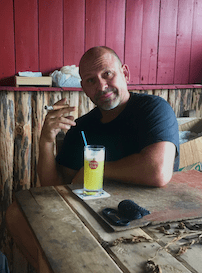
Kenny Davis
Kenny Davis has been working as a Dolly Grip for thirty years, building his reputation as one of the best in the business. He has worked for the top Directors in the industry such as Steven Soderbergh, David Fincher, Chris Nolan, James Cameron, and Paul Thomas Anderson.
His many, many credits include critically-acclaimed features and television shows including Boogie Nights, The Cable Guy, Memento, Get Him to the Greek, Magic Mike XXL, The Magnificent Seven, Mindhunter, House of Cards, Mad Menand Logan Lucky. He’s currently working on Devil In The Grove with Bradford Young and Anton Corbijn.
